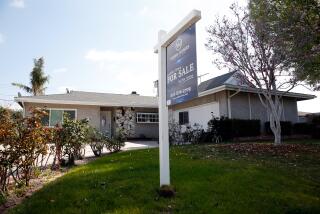California housing recovery may gain momentum, experts say
New foreclosures in California fell sharply in January as state rules for banks took effect, signaling that repossessions may finally settle in at levels not seen since before the housing bust.
The resulting decline in bank-owned properties listed for sale on the market — as well as record numbers of investors prowling for bargains — should give the state’s housing recovery momentum this year, experts said.
In the Southland, the new year kicked off with a sharp annual gain in sales, the highest volume for a January in six years. The region’s median home price notched a sharp 23.5% gain over the same month last year. And new foreclosure actions plummeted statewide.
“The recovery is for real, that is what I think is happening,” said Esmael Adibi, director of Chapman University’s A. Gary Anderson Center for Economic Research. “It is being driven by real demand, and fundamentals are favorable.”
The price gains reflect a shift in the market away from foreclosures and toward regular sales, indicating a recovery on solid ground, said Christopher Thornberg, founding principal at Beacon Economics.
“The question is, is it the real deal?” Thornberg said. “Sure it is. It is driven of course by a very tight market … about as tight as it gets, and ultimately inventory drives prices.”
Although prices may be gaining, the healthiest contributors to housing strength — employment gains and consumer confidence — appear to be playing less of a factor than investor activity and low mortgage interest rates. That’s cause for some concern, but the housing market still has a long way to go to recover from its peak summer 2007 levels, DataQuick President John Walsh said.
“This fledgling housing recovery has momentum,” Walsh said in a statement. “Already, price hikes have caused some to question whether it’s sustainable, whether it’s a ‘bubble.’ Let’s not forget, though, that we’re still climbing out of a deep hole from the housing downturn.”
The home price and sales gains came as foreclosure starts in California took a massive tumble last month as new state laws aimed at prohibiting certain aggressive bank repossession practices went into effect. The real estate website ForeclosureRadar.com reported a 60.5% decline in California default notices in January from December.
The number of default notices — the first formal step in the state’s foreclosure process — fell 77.7% from January 2012. A total of 4,500 such filings were logged last month — the lowest number of default no-
tices since at least September 2006, when the website’s records begin.
The website noted that the foreclosure drop came in January, when a package of tough new laws protecting California homeowners went into effect. Most notably, the Homeowner Bill of Rights bans the practice of “dual tracking,” in which a lender seizes a home while the owner is negotiating to lower mortgage payments.
The laws also outlawed so-called robo-signing — the improper or faulty processing of foreclosure documents — and would allow state agencies and private citizens to sue financial institutions, under limited conditions, for economic compensation and for additional civil damages of up to $50,000. Passed last year, the legislative package was sponsored by California Atty. Gen. Kamala D. Harris and written by 10 Democratic lawmakers.
While dramatic, the drop is part of a general decline in foreclosure actions over the last year as banks look toward short sales and loan modifications as alternatives to seizing homes.
“You will see a continued decline in defaults from regulator activity, new laws and from the economy,” said Dustin Hobbs, a spokesman for the California Mortgage Bankers Assn. “As long as the economy, and especially the housing market, continues to slowly heal itself, you will see fewer and fewer defaults.”
Katherine Porter, a UC Irvine law professor who is monitoring the state’s accord with the nation’s five largest mortgage servicers over foreclosure abuses, said that it was not clear to her whether the dramatic drop in foreclosures resulted directly from new laws. The decrease could be temporary, she said, as mortgage servicers adjust their foreclosure processing systems.
Madeline Schnapp, director of economic research for ForeclosureRadar, believes the low levels of foreclosures will continue.
“The plethora of anti-foreclosure laws have been very effective in reducing foreclosure activity to what you are seeing today,” she said.
Foreclosed homes made up just 15% of the Southern California resale market last month, down dramatically from the worst of the crash, when they hit a high of 56.7% in February 2009, according to DataQuick. Short sales made up an estimated 25.9% of January’s resale market.
Fewer foreclosures will probably lead to more gains in home prices, because foreclosures have been the main supply of cheap housing. But rising prices also will lift more underwater homeowners out of a negative equity position, helping them sell their homes, which could also loosen up supply.
Buyers paid a median $321,000 last month in Southern California, a reflection of rising prices and a shift in the buying mix from lower-end starter homes to pricier digs.
Sales of homes in the region’s move-up market have continued to gain. Sales of homes priced from $300,000 to $800,000 soared 49.6% year-over-year in January, while sales of homes costing more than $500,000 jumped 74% from a year earlier.
Meanwhile, sales of homes costing less than $200,000 fell 23.5% from the previous January, an indication of tight inventory levels in those markets as investors look to snap up houses and rent them out.
Times staff writer Andrew Khouri contributed to this report.
More to Read
Inside the business of entertainment
The Wide Shot brings you news, analysis and insights on everything from streaming wars to production — and what it all means for the future.
You may occasionally receive promotional content from the Los Angeles Times.










